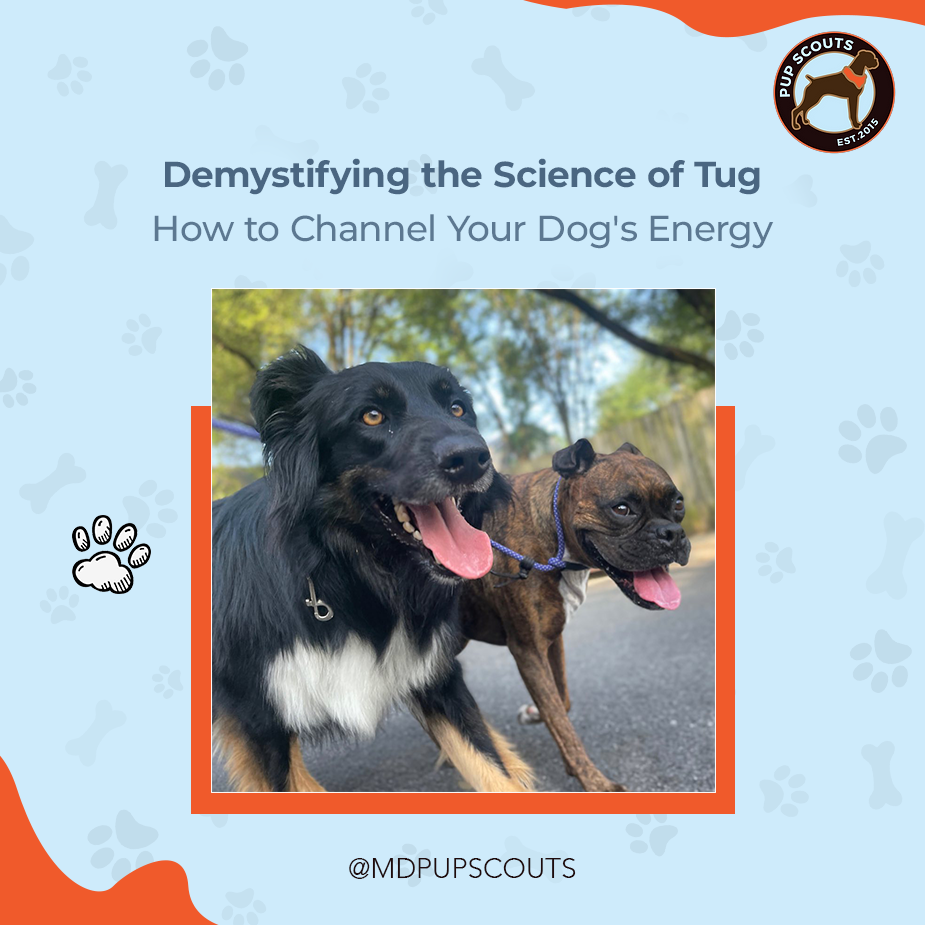The Science of Tug: How to Channel Your Dog’s Energy

Harness your dog’s energy through proper rules and science-based techniques.
Tug is one of the oldest and most basic games we play with our dogs and for a good reason. While it is true that tug uses the “prey drive” part of the brain, we can increase their self-control by rehearsing this and establishing rules. Tug is a fantastic energy burner that enriches your dog through exercise and strengthens your bond through cooperative dissection. However, there has been a spate of conflicting content regarding tug in recent years, and I felt inspired to clear up some of this misinformation.

Tug is a fantastic energy burner for dogs.
In addition to doing some myth-busting, I will also let you know which dogs shouldn’t be playing and then go through some rules that help make tug more fun for you both.
By the end (spoiler alert), you’ll know why it’s not only okay for dogs to tug but that it is vitally important for most of them to do so. Let us jump right in!
Dogs that shouldn’t tug

Understanding when not to indulge your dog in tug

Common reasons often cited to avoid tug games
- It seems obvious, but if your dog is injured or is recovering from a physical malady, he shouldn’t be playing this very physical game. They can aggravate or worsen nagging injuries, and it would be best to check with your vet regarding acceptable activity levels.
- Dogs recovering from tooth or mouth troubles also should avoid tugging as it can exacerbate any dental issues the dog may have. Some teething puppies require different types of tug toys, and it is crucial to keep sessions short. When in doubt, ask your vet.
- The final group that should avoid playing tug are dogs with an unknown history with people. If you have a new rescue, you should wait until you know the dog’s temperament before starting rough-and-tumble games.
- Lastly, a dog with a known history of unprovoked people aggression shouldn’t be tugging, and those dogs should be in the hands of a qualified veterinary behaviorist.
Assuming your dog is physically and mentally stable, they have the green light to tug. But first, let’s go over the list of the most common reasons owners might be told to avoid tug games with their dogs.
1. Tug can activate a dog’s prey drive and make them go after small animals.
It is a common warning that I hear, usually centered around making sure that dogs don’t play with leather or furry toys (i.e., reminiscent of an animal’s body). The reason is that it will make them want to chase rabbits or squirrels. It has led to some folks saying that no sporting breeds (pointer, retriever, etc.) should play tug because it encourages them to be less cautious with their mouth and increase predation behaviors.
Fortunately, we now know that this is just some bad math on the part of well-intentioned people. While it is true that tug uses the “prey drive” part of the brain, we can increase their self-control by rehearsing this and establishing rules. Studying frequent repetition of tug games has proved that it has the opposite effect; honing a dog’s ability to discern between play objects and assessing a partner’s ability.
2. Tugging is a way for your dog to display dominance over you.
I would give anything for the “dominance” myth to die out. If you didn’t know already, your dog is *NEVER* trying to be dominant over you. They are also not trying to be any alpha or leader. This has been debunked repeatedly, but it’s been an easy sell as a “quick fix” to exasperated dog owners.
Unfortunately, owners can hear growling and vocalizations from an aroused dog, which can be intimidating. We know that dogs have an entire repertoire of communicative noises that they will use based on context. Because external factors are all key to assessing an animal’s (or human) well-being, we can be positive that a dog that growls during tug isn’t going to start growling all the time or try to become the head of the household.

Dogs have an entire repertoire of communicative noises
3. Fighting your dog for something they want will make them a resource guard.
Simply put, a dog that does not have a history of resource guarding will not suddenly develop the behavior during a game of tug. If your dog is an established resource guarder, you want to start by limiting its access to resources. After that, you should consider consulting with a veterinary behaviorist to assess how to tackle the problem.
Tug is a cooperative game, and the owner is the primary reason it’s any fun at all. You make that wet gross rope come to life! Have you ever noticed how bored your dog becomes with a toy you’ve stopped tugging? It’s because you are your dog’s favorite part of the game.
4. Tugging makes a dog overexcited, and they can redirect and bite you or another dog.
It can be valid if your game of tug is a frantic free-for-all. If dogs keep escalating their arousal without being checked, there is a chance that something could go wrong. However, when a tug is played with rules in place, it works to help strengthen their resiliency for higher-impact play.
In other words, by setting up boundaries for how and when the game takes place, you end up with a dog with a higher arousal threshold than before. The more tug you play, the harder they are to rile up!
THE RULES OF ENGAGEMENT

Tugging improves dog and owner’s relationship because it helps establish boundaries.
The quality of our relationship with our dog dictates our quality of life together. Tugging improves that relationship because it helps establish boundaries. It’s great to start young by setting these rules, but it’s also never too late!
1. Thou shalt know when to stop
Playing tug with puppies is a great way to teach them these boundaries, but it’s important to keep your sessions very short as their attention span only allows so much learning at one time (same here, pups, same here).
When I have a puppy engaged in tug, I will draw the toy close to my chest after only a few seconds of play. When the puppy releases, I instantly give them back the toy with the cue “get it”. This is a simple way to tell the dog, “If you do what I want you to do, you get what you want”. Very quickly, the dog learns to drop the toy when we draw it close (if they don’t, hide it in your hands and be as boring as possible without letting go).
When the dog is consistently dropping the toy, we can add a verbal cue by giving the cue just before we draw the toy to our chest. I like the word “out”, but your options are limitless. Occasionally I will give them a treat and return the toy to them. It creates a dog that is very excited for us to give the “out” cue.
2. Honor thy owner by minding thy teeth
If any part of your mouth comes off the toy and goes to my clothes or my skin, the game will end, even by accident. It should be similar to an elevator’s “Emergency Stop” button. We aren’t mad or scolding the dog; we don’t need to. Cessation of the game is punishment enough.
We are simply saying, “You hit my skin, so the game ends for now”. This is the golden rule of tugging: a dog’s mouth coming into contact with my skin is inappropriate communication and ends all fun things. If you establish this as a puppy, they will pick up our boundaries faster than expected.
3. Do not covet (those other toys)
One of the reasons that tugging can positively impact your relationship with your dog is because it teaches the dog that having their focus on you pays dividends. Using various toys to tug (even mid-game) teaches the dog that you are the fun part of tug, not the toy itself.
It will bleed into other areas of your training and serve to keep the dog’s attention on you, even when you aren’t directly engaging them. Switching toys regularly is also a great way to help prove against resource guarding in puppies by keeping the excitement around the handler rather than the object.
4. Safety first!
Tug should be played in safe environments. Because watching other dogs tug can be incredibly arousing for other dogs in the area, I recommend playing tug only when your dog is the only one in the area.

Tug should be played in safe environments
Other Tug Tips:
To limit the risk of injury and maximize their traction, only play tug in areas where they can get a grip: no hardwood or tile.
Be clear in your expectations. Don’t relax the rules because of other factors. If a dog accidentally gets you with their teeth, it doesn’t help for you to ignore it. Your time-outs don’t need to be long, but you need to be clear in your expectations by not easing them.
Toy selection matters quite a bit. There is no one-size-fits-all toy that works for every dog, but it’s important that whatever you use allows you to keep your hand away from the dog’s mouth.
Don’t approach the dog directly. How many rabbits would walk up to your dog and throw themselves at them? Rather than going toward the dog (which rabbits or squirrels would never do), we can trigger their predatory drive more by either running away from them or pulling the toy away from you when beginning the game.
Your mechanics matter! When you’re tugging, the primary orientation of the toy must be from side to side. That way, you are going in a way that the dog’s neck can bend. Many folks look like they’re shaking out bed sheets when they Tug, and unfortunately, the dog’s neck isn’t meant to be bent back like that. Go with the physiology of the dog so that they can brace themselves. The easiest way to do that is to be the “anchor” and let the dog provide the motion.

Toy selection matters quite a bit.
So that’s it! Tug is a powerful reinforcer, energy burner, and enrichment tool, and let’s face it: it is fun! If you have questions or would like help setting up a training plan to teach a reluctant dog, reach out to me at dominic@mdpupscouts.com
Happy Tugging, and tell your dog I said hi!

The Science of Tug: How to Channel Your Dog’s Energy
Tug is one of the oldest and most basic games we play with our dogs and for a good reason. While it is true that tug uses the “prey drive” part of the brain, we can increase their self-control by rehearsing this and establishing rules. Tug is a fantastic energy burner that enriches your dog […]

